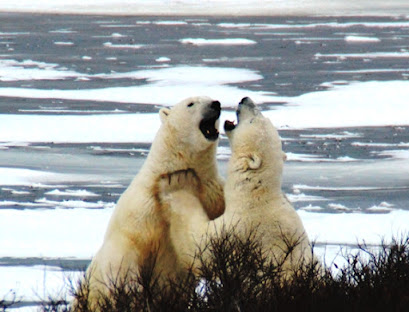Magnificent polar bears at Churchill, Canada
Just inches
from my feet, two shiny black eyes stare up at me through the metal mesh floor
of our Polar Rover. A bear cub lifts his button nose as if to check out the
scent of my heavily padded boots. I’m furiously taking pictures, camera in burst
mode, in hopes of capturing a few good shots of this incredible moment.
We’re in
Churchill, Manitoba, Canada—1,000 miles north of Winnipeg--on a polar bear
expedition, hunting with our eyes and our cameras. It’s polar bear season, a
six-week period during October and November when hundreds of polar bears
migrate to this area on their way to Hudson Bay. When the sea freezes over, seal-hunting
season begins. After fasting during
spring and summer, bears are ready to hunt (and eat) seals to fatten up before
they again enter a period of living off their fat reserves.Mother and cub walk over the slushy ice of Hudson Bay, not yet
frozen over.
Why Hudson Bay?
Hudson Bay is
the first place that gets iced over each fall. Located in the middle of the
North American continent, this region has no coastal waters to moderate
temperatures. Also, the Churchill River, which drains from the Rocky Mountains,
flows into Hudson Bay. Being fresh water, it freezes at a slightly higher
temperature than salt water. Aided by
strong counter-clockwise currents, the bay can freeze very quickly forming
prime hunting grounds for bears-in-waiting.
Journey to the Far North
We’re
traveling with Natural Habitat, a leading tour company that partners with World
Wildlife Fund to offer a variety of 6- and 7-day environmentally responsible
wildlife excursions. While this is my favorite adventure tour company (we have
gone on numerous adventures with them), other tour companies also provide
similar itineraries in Churchill.
We overnight
in Winnipeg where we are issued right-sized parkas and snow boots. These are
snuggly warm and comfortable, eliminating the need to cram-pack or carry bulky
items while traveling.
An informative dinner introduces us to our
guide, Drew Hamilton, whose photos and commentary whet our appetites even more
for the experiences we’re about to have. Because no roads go into Churchill,
the following morning a charter flight whisks us to the outpost town of 800
residents. The other option would have been a 52-hour train ride. Bears are curious. This one checks out the 6-foot tires
on the specially-built Polar Rover.
Polar Bear Capital of the World
Although more
than 14,000 visitors are expected during the peak season, the number of vehicles
allowed each day on the government-owned 26-by-7-mile tundra region where polar
bears congregate is highly regulated.
With only 16 people in our group, everyone has a comfortable window seat
from which to observe the bears and take photos. On the back of the
specially-built Polar Rover is an elevated outside observation deck. This is
where I come face-to-feet with the bear cub.
Adventure in the tundra
Our first
tundra excursion starts shortly before sunset. In the dimming light we soon
cross paths with a polar bear family—mom and two cubs about eight or nine
months old—that we watch slosh through semi-frozen puddles and muddied snow. We
see tracks of an Arctic fox but no sign of the elusive camouflaged animal.
Male bears practice sparring skills that may be needed later.
At dusk we
come upon a group of three male bears. One is sleeping and uninterested in bear
society, but the other two put on an amazing show of sparring, bear form of
play-fighting. Raring up on hind legs, they nip at each other with open mouths,
exposing long sharp incisors that could do plenty of damage under other
circumstances. Pushing and shoving each
other with their huge paws in a pseudo-wrestling match, these enormous animals
practice skills they may need later. Sunset is a fiery feast of red hues.
Just before
nightfall, streaks of scarlet red, orange, and yellow spread upon the clouds
turning the horizon into a fiery blaze. Reflections on not-yet-frozen pools and
dazzling snow-tipped vistas broken occasionally by scrubby reddish willows or
brown boulders reveal a splendor unique to tundra landscapes.
Our first full
day on the tundra yields about 20 bear sightings, with an equal number the
following day, and more on our evening excursion—all observed from the comfort
of our Polar Rover bus. Male bears
enchant onlookers with their sparring antics, mama bears keep watchful eyes on
wandering cubs, and one male bear shows dominance by approaching another bear
in a way that causes it to retreat.
Numerous bears sleep or stroll across thin ice, while others meander
close to the Rover, poking around and climbing on the six-foot tires to check
out their surroundings.Polar bears are fascinating to observe in the wild.
Bears in the wild
Viewing these
magnificent animals in their natural habitat is an incredible experience, but
we’re constantly reminded that they are wild creatures. On the tundra we never
leave the Polar Rover. Signs throughout town, where we stay in a basic but
comfortable hotel, warn locals and visitors that this is bear territory. If an
unruly bear wanders into town, it is captured and held for several days before
being helicoptered back to the tundra.

Push comes to shove in good-natured fun.
Almost half
the world’s population of polar bears (estimated numbers range up to 40,000)
lives in northern Canada. Warmer temperatures from climate change may affect their
natural habitat as ice starts to form later, allowing less time for bears to
hunt and build up stores of fat. In the U.S. polar bears have been considered
threatened since 2008, although they’re not endangered.
If you're craving a nature adventure that's extraordinarily
inspiring, I suggest an expedition to Churchill to view polar bears in the
wild.
A version of this
story first appeared in NowU in 2014.
Photos by Larry and
Beverly Burmeier














No comments:
Post a Comment